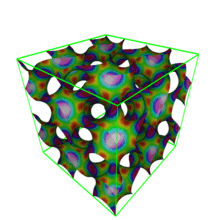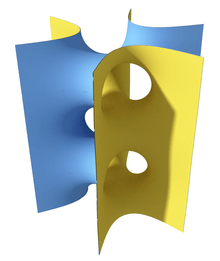Gyroid

A gyroid is an infinitely connected triply periodic minimal surface discovered by Alan Schoen in 1970.[1][2]
History and properties
The gyroid is the unique non-trivial embedded member of the associate family of the Schwarz P and D surfaces with angle of association approximately 38.01°. The gyroid is similar to the Lidinoid. The gyroid was discovered in 1970 by NASA scientist Alan Schoen. He calculated the angle of association and gave a convincing demonstration pictures of intricate plastic models, but did not provide a proof of embeddedness. Schoen noted that the gyroid contains neither straight lines nor planar symmetries. Karcher[3] gave a different, more contemporary treatment of the surface in 1989 using conjugate surface construction. In 1996 Große-Brauckmann and Wohlgemuth[4] proved that it is embedded, and in 1997 Große-Brauckmann provided CMC variants of the gyroid and made further numerical investigations about the volume fractions of the minimal and CMC gyroids.
The gyroid separates space into two oppositely congruent labyrinths of passages. The gyroid has space group Ia3d. Channels run through the gyroid labyrinths in the (100) and (111) directions; passages emerge at 70.5 degree angles to any given channel as it is traversed, the direction at which they do so gyrating down the channel, giving rise to the name "gyroid". One way to visualize the surface is to picture the “square catenoids” of the P surface (formed by two squares in parallel planes, with a nearly circular waist); rotation about the edges of the square generate the P surface. In the associate family, these square catenoids “open up” (similar to the way the catenoid “opens up” to a helicoid) to form gyrating ribbons, then finally become the Schwarz D surface. For one value of the associate family parameter the gyrating ribbons lie in precisely the locations required to have an embedded surface.
The gyroid refers to the member that is in the associate family of the Schwarz P surface, but in fact the gyroid exists in several families that preserve various symmetries of the surface; a more complete discussion of families of these minimal surfaces appears in triply periodic minimal surfaces.
Curiously, like some other triply periodic minimal surfaces, the gyroid surface can be trigonometrically approximated by a short equation:
The gyroid structure is closely related to the K4 crystal (Laves' graph of girth ten).[5]
Applications
In nature, self-assembled gyroid structures are found in certain surfactant or lipid mesophases[6] and block copolymers. In the polymer phase diagram, the gyroid phase is between the lamellar and cylindrical phases. Such self-assembled polymer structures have found applications in experimental supercapacitors,[7] solar cells[8] and nanoporous membranes.[9]
Gyroid membrane structures are occasionally found inside cells.[10]
Gyroid structures have photonic band gaps that make them potential photonic crystals.[11] Gyroid structures have been observed in biological structural coloration such as butterfly wing scales, inspiring work on biomimetic materials.[12][13] The gyroid mitochondrial membranes in tree shrew cones might have an optical function.[14]
In 2017, MIT researchers studied the possibility of using the gyroid shape to turn bi-dimensional materials, such as graphene, into a three-dimensional structural material with low density yet high tensile strength.[15]
Researchers from Cambridge University have shown the controlled chemical vapor deposition of sub-60 nm graphene gyroids. These interwoven structures are one of the smallest free standing graphene 3D structures. They are conductive, mechanically stable and easily transferable, and of interest for a wide range of applications.[16]
References
- ↑ Schoen, Alan H. (1970). "Infinite periodic minimal surfaces without self-intersections," (PDF).
- ↑ Hoffman, David (June 25 – July 27, 2001). "Computing Minimal Surfaces". Global Theory of Minimal Surfaces. Proceedings of the Clay Mathematics Institute. Berkeley, California: Mathematical Sciences Research Institute.
- ↑ Karcher, Hermann. "The triply periodic minimal surfaces of Alan Schoen and their constant mean curvature companions". manuscripta mathematica. 64 (3): 291–357. doi:10.1007/BF01165824. ISSN 0025-2611.
- ↑ Große-Brauckmann, Karsten; Meinhard, Wohlgemuth. "The gyroid is embedded and has constant mean curvature companions". Calculus of Variations and Partial Differential Equations. 4 (6): 499–523. doi:10.1007/BF01261761. ISSN 0944-2669.
- ↑ T. Sunada, Crystals that nature might miss creating, Notices of the AMS, 55(2008), 208-215
- ↑ Longley, W. & McIntosh, T. J. 1983 A bicontinuous tetrahedral structure in a liquid crystalline lipid. Nature 303, 612–614.
- ↑ Wei D, Scherer MR, Bower C, Andrew P, Ryhänen T, Steiner U. A nanostructured electrochromic supercapacitor. Nano Lett. 2012 Apr 11;12(4):1857-62.
- ↑ Crossland EJ, Kamperman M, Nedelcu M, Ducati C, Wiesner U, Smilgies DM, Toombes GE, Hillmyer MA, Ludwigs S, Steiner U, Snaith HJ. A bicontinuous double gyroid hybrid solar cell. Nano Lett. 2009 Aug;9(8):2807-12.
- ↑ Li L, Schulte L, Clausen LD, Hansen KM, Jonsson GE, Ndoni S. Gyroid nanoporous membranes with tunable permeability. ACS Nano. 2011 Oct 25;5(10):7754-66. Epub 2011 Sep 14.
- ↑ S. Hyde, Z. Blum, T. Landh, S. Lidin, B.W. Ninham, S. Andersson, K. Larsson, The Language of Shape: The Role of Curvature in Condensed Matter: Physics, Chemistry and Biology, Elsevier, 1996
- ↑ Martin-Moreno, L., Garcia-Vidal, F. J. & Somoza, A. M. Self-assembled triply periodic minimal surfaces as molds for photonic band gap materials. Phys. Rev. Lett. 83, 73–75. 1999
- ↑ Saranathan V, Osuji CO, Mochrie SG, Noh H, Narayanan S, Sandy A, Dufresne ER, Prum RO. Structure, function, and self-assembly of single network gyroid (I4132) photonic crystals in butterfly wing scales. Proc Natl Acad Sci U S A. 2010 Jun 29;107(26):11676-81.
- ↑ Michielsen K, Stavenga DG. Jun 14. J R Soc Interface. 2008 Jan 6;5(18):85-94. Gyroid cuticular structures in butterfly wing scales: biological photonic crystals.
- ↑ Zakaria Almsherqi, Felix Margadant and Yuru Deng. A look through ‘lens’ cubic mitochondria. Interface Focus (2012) 2, 539–545
- ↑ Researchers design one of the strongest, lightest materials known, MIT news
- ↑ Cebo, T.; Aria, A. I.; Dolan, J.A.; Weatherup, R. S.; Nakanishi, K.; Kidambi, P. R.; Divitini, G.; Ducati, C.; Steiner, U.; Hofmann, S. (2017). "Chemical vapour deposition of freestanding sub-60 nm graphene gyroids". Appl. Phys. Let. 111 (25): 253103. doi:10.1063/1.4997774.
External links
- Triply Periodic Minimal Surfaces at schoengeometry.com
- Gyroid at MathWorld
- Rotatable picture of a gyroid's period
- The gyroid at loomington's Virtual Minimal Surface Museum
